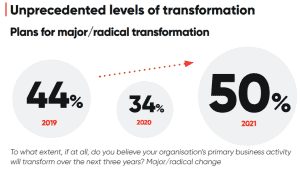Realising the benefits of digital transformation in the post-pandemic era

Digital transformation has become a frequently used but often ill-defined term over the last few years. It seems to be a catch all phrase for many businesses and is a key strategic initiative for businesses globally. But what does digital transformation really mean for businesses in the post-pandemic era?
The 2021 Digital Leadership Report from Nash Squared shared that “during the pandemic there was a massive surge of unplanned tactical technology spend. Although some organisations were forced to pivot their business models, most were focused on workforce enablement. Consequently, we saw a dip in 2020 for those organisations transforming themselves. As we emerge from the crisis it appears that the focus is now firmly back on transformation: either through introducing significant new products and services or changing business models altogether.”

Snippet of Digital Leadership Report 2021
A recent survey by McKinsey shows that 64% of 1,140 business executives say that they need to build new digital businesses as they view technology capabilities as a strategic differentiator to keep up with new demands.
Digital transformation is not just a simple single step, it’s the whole journey that requires companies to get onboard and explore what suits them the best along the way. As there is no ‘silver bullet’ that can guarantee the success of digital transformation, truly understanding what it is and what the future might hold is that first step you need to take.
Defining digital transformation
We look upon digital transformation as a way of rethinking how an organisation operates internally and externally, online and offline. To further their journey, companies need to take a step back to look at how they use, and utilise, technology, people, and processes. The outputs and findings will then be considered with one big question at the centre: is there room for change, of any kind, that enables better decision-making, increased efficiencies, or enhanced customer experience?
There are many paths on the way to digital transformation and no journey will be the same. One company might utilise machine learning and data analytics to make spot-on predictions on customers’ preference while the other might introduce application modernisation to minimise the legacy burden to their business. It could be the implementation of digital platforms such as mobile apps or websites that accelerate the customer experience or leverage technologies to shift from a traditional business to a digital one.
Sounds complicated? Think of how we moved from in-person banks to mobile banking, how we moved from cash to cashless and bankless payments. Think of how we moved from bricks-and-mortar video rental services to Netflix? That’s how digital transformation is being translated into our lives.
The importance of digital transformation
Prior to the pandemic, digital transformation may have been seen as just the cherry on the cake for organisations. Now, the pandemic has pushed businesses over the technology tipping point and transformed them for good. It has become the ticket to stay ahead of the curve and remain competitive.
A recent study shows that nearly 87% of executives have shifted their mindset and stated that their current strategic posture toward technology is to either modernise the core, invest more to make it a competitive advantage or to refocus the business on digital technologies.
What are the benefits of doing that, you may ask? We believe there are plenty – let’s dive in.
- Unlocking the values of data: Mountains of data are being collected by most businesses but not many of them are able to realise the true value of it. Digital transformation helps you to translate collected data into valuable insights, which fosters business intelligence at a higher level. With a more comprehensive understanding in customers and their preferences, businesses can create customer-centric strategies to provide more relevant and personalised content and solutions
- Accelerating efficiency: Using the right technology, powered by its ability to automate manual tasks and integrate data, can help streamline workflow and processes and thus, enhance efficiency within your organisation
- Enhancing customer experience: In the modern world, with broader choices, customers are having higher expectations for their digital experiences than ever. More than two-thirds of respondents in a recent study from Gartner claimed that customer experience (CX) has become their new battleground. With the use of technology, digital transformation offers more enhanced, seamless and intuitive experiences for customers and clients
- Reducing unwanted costs: To transform is to get rid of any kind of burden on your shoulders. By modernising your systems and applications with the help of cloud and other technologies, businesses are also able to reduce the maintenance costs attached to legacy code
- Accelerating digital culture: Digital transformation also encourages a digital culture. Advanced hi-tech tools not only offer a more effective way to collaborate seamlessly but also help drive businesses forward in the digital world. Digital culture is vital to sustainability since it fosters the constant upskilling and learning of members in the organisation to keep up with the pace
The journey to success
There is no predefined roadmap that is one size fits all. But there are certain steps that companies might want to take to accelerate the journey.
1. Adopt an agile mindset – Agility is the foundational component to digital transformation. Although there are many challenges, accepting the concept of being agile is probably where you want to start since it encourages experimentation and makes room for innovative ideas to grow
2. Reimagine the business – Transformation should be built around the customer-centric approach. Think of how to leverage the power of technology to boost operational efficiency and react proactively to surging customer expectations
3. Start mapping out the plan and strategy – You need to sit down and ask; “What do you want to get out of this? What are the barriers that need to be overcome? What are the things that need to be done?”. By doing this, you will have a clear vision and the right transformation strategy to help you navigate throughout the journey
4. Align with other departments and co-create – At the end of the day, digital transformation requires a new mindset to drive fundamental changes to the whole organisation. As such, cross-departmental collaboration in aligning business-focused strategies, dismantling the silos and synchronising the goals is a necessity to co-create success
5. Retrain employees and get them prepared for the digital world – People are the key pillar that keeps companies standing strong. Businesses need to ensure their employees are on the same page and fully ready before making any digital moves
Digital transformation is a complex journey, and we get that. If you feel like you’re on your own and not sure where, or how, to start, partnering up with someone will help you realise your potential to fulfil your digital ambition.
The key to success is to work with a trusted partner who has real-life experience of understanding and developing strategies and options that work, gained by helping other companies through their own digital transformation journeys.
Learn more about the NashTech approach or arrange a call to discuss how we can help, email info@nashtechglobal.com.
Suggested articles

From rising above adversity to riding the wave of digital transformation in the education sector
Explore how NashTech help Trinity College London ride the wave of digital transformation in the education sector

Migrating and modernising the virtual learning environment to AWS for an enhanced experience
The migrated and modernised Moodle infrastructure means that The Open University can now take advantage of cloud benefits.

A glimpse into a year-long RPA journey with a leading digital advertising service
A glimpse into a year-long RPA journey with a leading digital advertising services and solutions provider and how NashTech helped them.
We help you understand your technology journey, navigate the complex world of data, digitise business process or provide a seamless user experience
- Topics:


